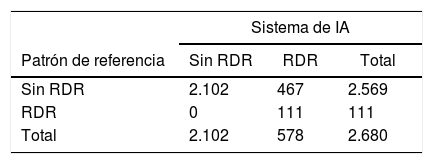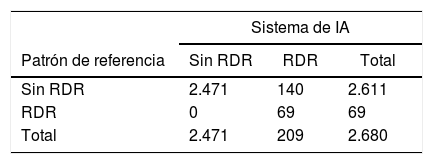Comparar el rendimiento diagnóstico de un sistema de inteligencia artificial (IA) de diagnóstico autónomo para el diagnóstico de retinopatía diabética derivable (RDR) con la clasificación manual.
Materiales y métodosSujetos con diabetes tipo 1 y 2 participaron en un programa de cribado de retinopatía diabética (RD) entre 2011-2012. Se recogieron dos imágenes de cada ojo. Se obtuvieron imágenes retinianas no identificables, una centrada en el disco y otra en la fóvea. Los exámenes se clasificaron con el sistema de IA autónomo y manualmente por parte de oftalmólogos anónimos. Los resultados del sistema de IA y de la clasificación manual se compararon en cuanto a sensibilidad y especificidad para el diagnóstico tanto de RDR como de retinopatía diabética con disminución de la visión (VTDR).
ResultadosSe incluyeron 10.257 retinografías de 5.360 ojos de 2.680 sujetos. De acuerdo con la clasificación manual, la prevalencia de RDR fue de 4,14% y la de VTDR de 2,57%. El sistema de IA registró un 100% (95% IC: 97-100%) de sensibilidad y un 81,82% (95% IC: 80-83%) de especificidad para RDR, y un 100% (95% IC: 95-100%) de sensibilidad y un 94,64% (95% IC: 94-95%) de especificidad para VTDR.
ConclusionesEn comparación con la clasificación manual, el sistema de IA de diagnóstico autónomo registró una sensibilidad (100%) y una especificidad (82%) elevadas en el diagnóstico de RDR y edema macular en personas con diabetes. Debido a su diagnóstico inmediato, el sistema de IA de diagnóstico autónomo puede aumentar la accesibilidad al cribado de RDR en contextos de atención primaria.
To compare the diagnostic performance of an autonomous diagnostic artificial intelligence (AI) system for the diagnosis of derivable diabetic retinopathy (RDR) with manual classification.
Materials and methodsPatients with type 1 and type 2 diabetes participated in a diabetic retinopathy (DR) screening program between 2011-2012. 2 images of each eye were collected. Unidentifiable retinal images were obtained, one centered on the disc and one on the fovea. The exams were classified with the autonomous AI system and manually by anonymous ophthalmologists. The results of the AI system and manual classification were compared in terms of sensitivity and specificity for the diagnosis of both (RDR) and diabetic retinopathy with decreased vision (VTDR).
Results10,257 retinal inages of 5,630 eyes of 2,680 subjects were included. According to the manual classification, the prevalence of RDR was 4.14% and that of VTDR 2.57%. The AI system recorded 100% (95% CI: 97-100%) sensitivity and 81.82% (95% CI: 80 -83%) specificity for RDR, and 100% (95% CI: 95-100%) of sensitivity and 94.64% (95% CI: 94-95%) of specificity for VTDR.
ConclusionsCompared to the manual classification, the autonomous diagnostic AI system registered a high sensitivity (100%) and specificity (82%) in the diagnosis of RDR and macular edema in people with diabetes. Due to its immediate diagnosis, the autonomous diagnostic AI system can increase the accessibility of RDR screening in primary care settings.














